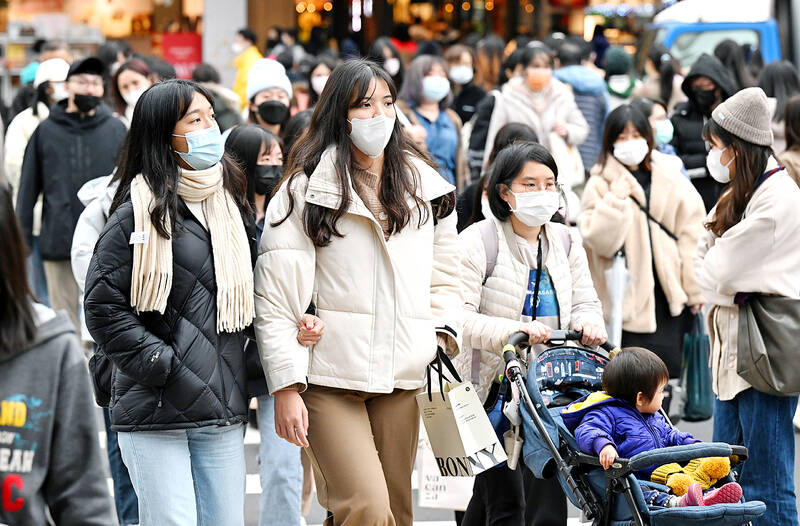COVID-19-related mask requirements could be further eased after the Lunar New Year holiday, the Central Epidemic Command Center (CECC) said yesterday, as it also reported that the Omicron BA.2.75 and BA.5 subvariants of SARS-CoV-2 have become the dominant strains circulating in Taiwan.
Centers for Disease Control (CDC) Director-General Chou Jih-haw (周志浩) reported 15,409 new local cases, about 9 percent down from the number reported on Monday last week, while new imported cases remain relatively high at 223, and 40 deaths from the disease were confirmed.
Deputy Minister of Health and Welfare Victor Wang (王必勝), who heads the center, said 151,838 new local cases were reported last week, which is a 15.7 percent decline compared with the previous week.

Photo: Liao Chen-huei, Taipei Times
The daily case trend suggests that Taiwan has passed the peak of its third wave of Omicron infections and new daily cases are dropping, but case numbers are expected to rebound after the Lunar New Year holiday, he said, adding that whether this would cause a “fourth wave” of infections is difficult to predict.
Wang said the center is planning to implement the second phase of mask mandate easing — which would only require masks in “high risk” indoor venues such as hospitals, long-term care facilities and public transportation — after the Lunar New Year holiday, if the COVID-19 situation remains stable.
The center also plans to downgrade COVID-19 as a category 4 notifiable communicable disease, he added.
Since the temporary arrival test requirement for travelers from China was implemented on Jan. 1, out of 22,057 China arrivals, 3,122 have tested positive, leading to a test positivity rate of 14.1 percent, Wang said, citing data as of Saturday.
CDC Deputy Director-General Chuang Jen-hsiang (莊人祥), who is the CECC spokesperson, said 224 people among 2,408 passengers who arrived from China on Saturday tested positive upon arrival, with a positivity rate of 9.3 percent.
Wang said the positivity rate has been decreasing, but the COVID-19 situation in China is still escalating and the virus is expected to spread from cities to rural areas during the Lunar New Year holiday.
Although new variants have not been detected among travelers from China, the testing program would continue until the end of the month, he said, adding that the center would assess whether it should be extended.
He said the genomic sequencing results on 157 virus samples from infected travelers from China showed that 61.8 percent were infected with the BA.5 strain, 36.9 percent with BF.7 and 1.3 percent with BQ.1.
Meanwhile, CDC Deputy Director-General Philip Lo (羅一鈞) said weekly genomic sequence surveillance data showed that the BA.2.75 subvariant has become a dominant strain, along with the current dominant BA.5 strain.
Of the sequenced imported cases — excluding travelers from China — last week, the BA.5 and BA.2.75 strains constituted 30 percent of the cases each, while the BQ.1 strain made up 20 percent and the XBB strain made up 13 percent, he said.
Of the sequenced local cases, 45 percent were infected with BA.5, followed by 41 percent infected with BA.2.75, Lo said, adding that the two subvariants are likely to constitute most local infections during the Lunar New Year holiday.
The XBB.1.5 subvariant has not yet been detected in Taiwan, Lo said.

Taiwanese were praised for their composure after a video filmed by Taiwanese tourists capturing the moment a magnitude 7.5 earthquake struck Japan’s Aomori Prefecture went viral on social media. The video shows a hotel room shaking violently amid Monday’s quake, with objects falling to the ground. Two Taiwanese began filming with their mobile phones, while two others held the sides of a TV to prevent it from falling. When the shaking stopped, the pair calmly took down the TV and laid it flat on a tatami mat, the video shows. The video also captured the group talking about the safety of their companions bathing

US climber Alex Honnold is to attempt to scale Taipei 101 without a rope and harness in a live Netflix special on Jan. 24, the streaming platform announced on Wednesday. Accounting for the time difference, the two-hour broadcast of Honnold’s climb, called Skyscraper Live, is to air on Jan. 23 in the US, Netflix said in a statement. Honnold, 40, was the first person ever to free solo climb the 900m El Capitan rock formation in Yosemite National Park — a feat that was recorded and later made into the 2018 documentary film Free Solo. Netflix previewed Skyscraper Live in October, after videos

Starting on Jan. 1, YouBike riders must have insurance to use the service, and a six-month trial of NT$5 coupons under certain conditions would be implemented to balance bike shortages, a joint statement from transportation departments across Taipei, New Taipei City and Taoyuan announced yesterday. The rental bike system operator said that coupons would be offered to riders to rent bikes from full stations, for riders who take out an electric-assisted bike from a full station, and for riders who return a bike to an empty station. All riders with YouBike accounts are automatically eligible for the program, and each membership account

A classified Pentagon-produced, multiyear assessment — the Overmatch brief — highlighted unreported Chinese capabilities to destroy US military assets and identified US supply chain choke points, painting a disturbing picture of waning US military might, a New York Times editorial published on Monday said. US Secretary of Defense Pete Hegseth’s comments in November last year that “we lose every time” in Pentagon-conducted war games pitting the US against China further highlighted the uncertainty about the US’ capability to intervene in the event of a Chinese invasion of Taiwan. “It shows the Pentagon’s overreliance on expensive, vulnerable weapons as adversaries field cheap, technologically